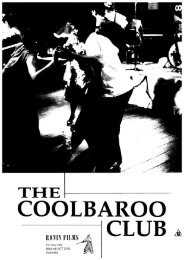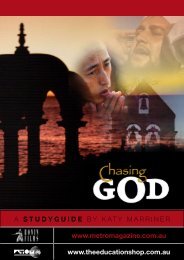to download BETELNUT BISNIS study guide - Ronin Films
to download BETELNUT BISNIS study guide - Ronin Films
to download BETELNUT BISNIS study guide - Ronin Films
You also want an ePaper? Increase the reach of your titles
YUMPU automatically turns print PDFs into web optimized ePapers that Google loves.
HANK<br />
HANK<br />
NELSON<br />
NELSON STUDYGUIDE<br />
1
Introduction<br />
Having lived in Papua New<br />
Guinea for thirty years, filmmaker<br />
Chris Owen worked<br />
among people he knew well. His easy<br />
familiarity with his neighbours is obvious<br />
in the relaxed way that the Papua<br />
New Guineans answer his questions.<br />
They seem unconscious of the camera.<br />
It is also clear that Owen is genuinely<br />
concerned about the lives of those that<br />
he interviews. Owen is not an intrusive<br />
cameraman, but he is not disinterested.<br />
When people are seen catching a bus,<br />
buying and selling in the market, or getting<br />
water for the house, again there is<br />
no sign that they are performing for the<br />
camera: they wander, chat, hesitate,<br />
and when they meet someone it looks<br />
as though the encounter is un-staged.<br />
The contrast is with films made by<br />
visiting crews who start filming within<br />
hours of leaving an aeroplane at Port<br />
Moresby’s Jackson’s Airport. They<br />
are concerned with the strange and<br />
dangerous and what they think viewers<br />
expect: palm trees bending over white<br />
sand beaches and lagoons, barebreasted<br />
women, outrigger canoes,<br />
exotic masks, bird of paradise plumed<br />
dancers, dense jungle, the hint of dangerous<br />
snakes and crocodiles, and a<br />
suggestion that the young men wearing<br />
dark glasses are members of criminal<br />
gangs. In the Highlands, the visiting<br />
camera crews capture peaks disappearing<br />
in<strong>to</strong> clouds, roads clinging <strong>to</strong><br />
cliff faces and fearsome tribal warriors<br />
armed with an assortment of bows and<br />
arrows, home-made guns and assault<br />
rifles. These film crews are gone in a<br />
few days, they have no further contact<br />
with those they filmed, and do not<br />
remember their names.<br />
Synopsis<br />
In Betelnut Bisnis, the central character,<br />
Lukas Kaima, from Chimbu Province,<br />
is living in Goroka, the main <strong>to</strong>wn in the<br />
neighbouring Eastern Highlands. Like<br />
an increasing number of Papua New<br />
Guineans he is living away from his<br />
clan lands, but for those trying <strong>to</strong> make<br />
their way in the <strong>to</strong>wns, finding cheap<br />
land and shelter is always hard. He and<br />
his wife Kopu have an agreement with<br />
local landowners who allow them <strong>to</strong> live<br />
on poor country on the edge of <strong>to</strong>wn.<br />
It is not suitable for gardening so they<br />
Papua New Guinea<br />
ISSUE 36 SCREEN EDUCATION<br />
2<br />
Once the separate Australian Terri<strong>to</strong>ry of Papua and the Australian Terri<strong>to</strong>ry<br />
of New Guinea held under trust from the United Nations, Papua<br />
New Guinea gained its independence in 1975 under the premiership<br />
of Michael Somare. In 2004, Somare, now Sir Michael, is again Prime<br />
Minister.<br />
The population is over 5,000,000 and growing rapidly. Papua New Guinea<br />
has a higher population than New Zealand.<br />
At independence, only half the children of school age were in primary schools,<br />
most of the adult population was illiterate, life expectancy was just over<br />
forty and infant mortality was high when compared with other low income<br />
countries. Most of these indica<strong>to</strong>rs have improved in thirty years of independence<br />
(adult literacy is probably now over 60%) but most people think that<br />
government efficiency has declined, corruption has increased and the country<br />
has become less safe as theft and violence has spread.<br />
The main exports of Papua New Guinea are the crops (copra, palm oil,<br />
coffee, cocoa, rubber and vanilla), timber, gold, copper and oil and gas.<br />
When Papua New Guinea changed <strong>to</strong> its own currency, the dollar became<br />
a kina and the cents <strong>to</strong>ia. Both names were taken from traditional shell<br />
money. One kina is now worth about half an Australian dollar, making<br />
imported goods expensive. The high cost of rice and canned foods makes<br />
life harder for people in <strong>to</strong>wns.<br />
Australia has been providing about $350 million in aid each year <strong>to</strong> Papua<br />
New Guinea and this is <strong>to</strong> be increased under the five-year enhanced<br />
cooperation agreement negotiated in 2003-4. Nearly 300 Australian police<br />
and public servants will work in Papua New Guinea <strong>to</strong> try and increase the<br />
government’s capacity <strong>to</strong> provide services for its people.
cannot grow their own food and the<br />
only water is distant and dirty.<br />
Kaima has known Chris Owen since<br />
2002. As a willing and skilled bush carpenter<br />
he worked with Chris, but apart<br />
from other casual labouring and taking<br />
the night shift as a security guard for<br />
the compound where Chris lives, he<br />
has no regular income.<br />
As he, his wife and members of his<br />
family are betelnut chewers, they need<br />
cash above the basic amount needed<br />
<strong>to</strong> pay for food. Also, they want money<br />
for school fees and emergencies. In Papua<br />
New Guinea there is no free education<br />
and almost no welfare system.<br />
Without pensions or unemployment<br />
benefits, people simply have <strong>to</strong> look<br />
after themselves. Many look <strong>to</strong> bisnis, a<br />
Tok Pisin (Papua New Guinean pidgin)<br />
expression taken from the English word<br />
‘business’, but having a wider meaning<br />
<strong>to</strong> include most money making ventures.<br />
Lukas long considers whether<br />
he might try his luck in the betelnut<br />
bisnis, and when he has some money<br />
he decides <strong>to</strong> risk it buying betelnut.<br />
He goes <strong>to</strong> Lae in the small buses on<br />
which the drivers yodel their destination<br />
<strong>to</strong> collect passengers, buys betelnut in<br />
the market, and returns, hopeful that he<br />
will make money.<br />
But after his wife has sold it, there is<br />
no profit. Lukas tries again by going <strong>to</strong><br />
Madang, but again there is no success.<br />
The betelnut bisnis requires a detailed<br />
knowledge of which sort of nuts<br />
people like <strong>to</strong> chew and the seasonal<br />
variations in prices. Also, Lukas is only<br />
bringing back one bag of betelnut, and<br />
he has <strong>to</strong> cover the cost of his bus fare<br />
and loss of the betelnut that he eats, or<br />
gives away <strong>to</strong> friends, or sells on credit.<br />
Lukas remains dependent on his uncertain<br />
income from labouring and working<br />
as a security guard.<br />
Jane Tamas is another significant<br />
person in the film and like Chris, she<br />
is a participant in both the events and<br />
the filming of them. A researcher and<br />
production assistant on the film, Jane<br />
is a young woman from the coast. She<br />
appears neatly dressed and competent,<br />
but we learn that she has had<br />
only five years of primary schooling<br />
and knows that she has <strong>to</strong> improve<br />
her education if she is <strong>to</strong> get on in life.<br />
But <strong>to</strong> do that she needs extra money.<br />
She teams up with Lukas’ wife <strong>to</strong> go<br />
The Highlands<br />
In the centre of Papua New Guinea there are five highland provinces:<br />
Eastern Highlands, Chimbu, Western Highlands, Enga and Southern<br />
Highlands. The highest peak, Mt Wilhelm, is 4500 metres (Mt Kosciuszko<br />
is 2230). When Europeans first tried <strong>to</strong> travel inland they were confronted<br />
by dense vegetation and harsh terrain. Ahead they could see more <strong>to</strong>wering<br />
peaks and they thought that the centre of the island of New Guinea<br />
was extremely mountainous and few people lived there. It was not until<br />
the 1920s and 1930s that European missionaries, gold prospec<strong>to</strong>rs and<br />
missionaries learnt that between the ranges were high, fertile valleys and<br />
dense populations. Nearly half the population of Papua New Guinea live in<br />
the Highlands.<br />
In the 1930s Australian government officers began bringing the Highlanders<br />
under central government administration. No battles of the Second<br />
World War reached the Highlands and many Highlanders scarcely knew<br />
that a world war was being fought in New Guinea. It was not until the<br />
1950s that government authority reached thousands of Highlanders.<br />
Many had only twenty years of Australian administration.<br />
An enterprising people, the Highlanders were soon leaving their villages<br />
(or scattered hamlets as many Highlanders did not live in concentrated<br />
villages) and trying <strong>to</strong> find work in the <strong>to</strong>wns and the plantations on the<br />
coast. This movement was assisted by the government sponsored Highlands<br />
Labour Scheme under which men contracted <strong>to</strong> work on plantations<br />
on the coast and in the islands. Lukas’ father was one who left home <strong>to</strong><br />
work on a coastal plantation.<br />
The longest and most important roads in Papua New Guinea connect the<br />
Highlands with Lae and Madang. While 85% of Papua New Guineans live<br />
in rural communities, many people, including thousands of Highlanders,<br />
live in the <strong>to</strong>wns.<br />
ISSUE 36 SCREEN EDUCATION<br />
3
in<strong>to</strong> the betelnut bisnis. Through her<br />
relatives on the coast she buys betelnut<br />
and brings it back for Kopu <strong>to</strong> sell in<br />
the market. There is just a chance that<br />
with their complementary skills the two<br />
women will succeed. While there are<br />
many successful male businessmen<br />
in Papua New Guinea, it is often said<br />
that women are the best traders in the<br />
market and the ones most likely <strong>to</strong> look<br />
after any small profits. This is a film of<br />
hardship and poverty, but not one without<br />
hope. Most of all, it is a revelation<br />
of the lives of ordinary people in Papua<br />
New Guinea—the people who do not<br />
appear on Australian television screens<br />
or in newspapers.<br />
Curriculum Links<br />
The film was made for SBS television,<br />
conforms <strong>to</strong> the fifty-two minutes of<br />
the television hour, and is appropriate<br />
for an adult audience. With its gentle<br />
and absorbing revelations of basic<br />
human ambitions it is also appropriate<br />
for tertiary students and the final three<br />
years of secondary school. Its primary<br />
relevance is <strong>to</strong> the social sciences and<br />
any courses where the aim is <strong>to</strong> extend<br />
understanding of the region. Given the<br />
increasing involvement of Australia<br />
in peacemaking on Bougainville, the<br />
Regional Assistance Mission <strong>to</strong> the<br />
Solomon Islands and Enhanced Cooperation<br />
in Papua New Guinea, this is of<br />
growing importance.<br />
Betelnut Bisnis could also be used<br />
in English classes where the main<br />
themes—relationships between people<br />
and their prospects in a difficult environment—can<br />
be discussed. For English<br />
(or language) students there is also<br />
the issue of the common language, Tok<br />
Pisin, used by Papua New Guineans<br />
when they wish <strong>to</strong> speak <strong>to</strong> those from<br />
another language group. (See ‘Language’<br />
overleaf.)<br />
Both Chris Owen and Andrew Pike<br />
have distinguished careers in film and<br />
their work should always be of interest<br />
<strong>to</strong> students of media.<br />
The filmmakers<br />
Andrew Pike and his wife Merrilyn<br />
Fitzpatrick have managed theatres in<br />
Canberra and run the company <strong>Ronin</strong><br />
<strong>Films</strong>. They have assisted in the production<br />
and distribution of major feature<br />
films such as Strictly Ballroom and<br />
Shine, and they have been involved in<br />
many award-winning Australian documentaries.<br />
From 1976, Chris Owen was involved<br />
in the training of Papua New Guinean<br />
Betelnut<br />
ISSUE 36 SCREEN EDUCATION<br />
4<br />
The tall betelnut palm (Areca catechu) grows on the coast and is commonly<br />
seen close <strong>to</strong> many villages. Most betelnut palms do not flourish in<br />
the Highlands although a few varieties are cultivated there.<br />
Betelnut chewers skin the nuts, chew the fruit, and <strong>to</strong> get the maximum<br />
impact add lime and the leaves or catkins of the vine, betel pepper. The<br />
chewers’ quid produces scarlet saliva, and when the chewers spit a red<br />
stain is left. Those who use it claim it has a nicotine-like effect, giving<br />
them a feeling of well-being and a greater capacity for work. In Tok Pisin<br />
betelnut is buai and the pepper is daka. The term spak (from the English<br />
‘spark’) means <strong>to</strong> be drunk, influenced by a drug.<br />
Chewing betelnut is a wide-spread habit among peoples from east Africa<br />
<strong>to</strong> India, Southeast Asia and Melanesia. As the film notes, it is the most<br />
commonly consumed drug after nicotine, alcohol and caffeine.<br />
Where it has long been used on the coast of Papua New Guinea betelnut<br />
is important in ritual and etiquette, and it has left its mark on artefacts<br />
such as the delicately carved lime spatulas and gourds. Some communities<br />
do not allow children <strong>to</strong> chew betelnut. But betelnut is new <strong>to</strong> most<br />
Highlanders who acquired the habit in postwar meetings with coastal<br />
people and with the opening up of airways and roads that enabled the<br />
growth in the betelnut trade.<br />
Growing, transporting and selling betelnut is a major industry and as<br />
most of it is outside the formal cash economy its full extent is difficult <strong>to</strong><br />
measure. In spite of attempts by some missions and governments <strong>to</strong> ban<br />
or limit the habit, the number of betelnut chewers has been growing.
filmmakers, a role he often carried out<br />
by working with them on projects in<br />
which they had considerable initiative.<br />
Owen’s own films have varied from<br />
carefully observed ethnographic films<br />
and contemporary documentaries <strong>to</strong><br />
the feature film Tukana, made on Bougainville<br />
with a cast which was speaking<br />
Tok Pisin and was new <strong>to</strong> film. Over<br />
the last twenty years most serious filmmakers<br />
who have gone <strong>to</strong> Papua New<br />
Guinea have called on Owen for advice<br />
and they have used his expertise and<br />
local knowledge, giving him work as an<br />
additional cameraman, sound recordist<br />
or edi<strong>to</strong>r. Apart from Tukana, another<br />
award-winning film by Chris Owen is<br />
Man without Pigs (1990), and again Andrew<br />
Pike worked with him on that film.<br />
In contrast <strong>to</strong> Betelnut Bisnis, Man<br />
without Pigs is about a Papua New<br />
Guinean, John Waiko, who has a doc<strong>to</strong>rate<br />
from the Australian National University<br />
and went on <strong>to</strong> become Minister<br />
for Education in the Papua New Guinea<br />
parliament. But Man without Pigs<br />
places John in his home village, where<br />
other skills, knowledge and wealth are<br />
significant.<br />
Chris Owen said in a recent interview<br />
for the press statement that accompanied<br />
the release of Betelnut Bisnis:<br />
I’m sure … that my presence with a<br />
camera influenced some events, but I<br />
was embedded in the process, and I<br />
just show what we did on a day-<strong>to</strong>-day<br />
basis—which included the making of<br />
this film. So essentially the camera is<br />
there and I’m there. I’m in the film, a<br />
participant observer, <strong>to</strong> use a phrase<br />
that I like.<br />
Chris Owen does not confront those<br />
he films, either with his camera or his<br />
questions. The camera is rarely hard<br />
up on the face of those interviewed;<br />
more often Chris takes a longer shot so<br />
that we see people in what <strong>to</strong> them are<br />
familiar surroundings. While he avoids<br />
<strong>to</strong>ugh questions, Owen’s technique encourages<br />
his informants <strong>to</strong> reveal more<br />
about themselves and their hopes and<br />
values than they would under <strong>to</strong>ugh<br />
interrogation. He makes no overt comments<br />
on the behaviour or values of<br />
Lukas and others, but the information<br />
is there in words and images for the<br />
viewers <strong>to</strong> draw their own conclusions.<br />
Because of Owen’s technique and<br />
because we have been led <strong>to</strong> an understanding<br />
of the material conditions and<br />
culture in which his interviewees live,<br />
any critical judgments are likely <strong>to</strong> be<br />
sympathetic rather than hostile.<br />
At the end of Betelnut Bisnis, Chris<br />
Owen reconsiders where he should<br />
work as a filmmaker; this film marks a<br />
significant moment in his life and in the<br />
his<strong>to</strong>ry of film in Papua New Guinea.<br />
Language<br />
There are many varieties of Pidgin<br />
English throughout the world, and<br />
those spoken in Papua New Guinea,<br />
the Solomons, Vanuatu and parts<br />
of Australia have significant differences.<br />
In Papua New Guinea there are<br />
over 700 different languages; no one<br />
Indigenous language is spoken by ten<br />
per cent of the population; and many<br />
are spoken by less than one per cent.<br />
There is a further complication: some<br />
languages are completely unrelated or<br />
only distantly related. Once Papua New<br />
Guineans from different places began<br />
meeting they were in need of a lingua<br />
franca.<br />
Papua New Guinea Pidgin or Tok Pisin<br />
(from ‘Talk Pidgin’) developed along<br />
the north coast of the mainland and in<br />
ISSUE 36 SCREEN EDUCATION<br />
5
the New Guinea islands. It may have<br />
been used by white English speakers<br />
attempting <strong>to</strong> trade, gain information<br />
or instruct house servants and plantation<br />
workers, but it rapidly became the<br />
language of New Guineans speaking<br />
<strong>to</strong> each other, especially where New<br />
Guineans from different languages<br />
were living close <strong>to</strong>gether and had <strong>to</strong><br />
communicate with each other. Among<br />
New Guineans, Tok Pisin was soon the<br />
language of the plantation labourers,<br />
the police, the prisons and the <strong>to</strong>wns.<br />
Even during the German administration<br />
of New Guinea from 1884 <strong>to</strong> 1914 Tok<br />
Pisin was a common language, and<br />
when the Australians arrived in 1914<br />
they proclaimed their control <strong>to</strong> the<br />
New Guineans of Rabaul in what they<br />
thought was Tok Pisin.<br />
Although much of the vocabulary of Tok<br />
Pisin has been derived from English,<br />
many words from other languages<br />
(including, of course, from Papua New<br />
Guinea) have been included. The rules<br />
of grammar differ from English and<br />
have been influenced by Papua New<br />
Guinean languages, and pronunciation<br />
has largely been determined by Papua<br />
New Guineans. English speakers,<br />
when they first hear Tok Pisin, cannot<br />
recognize most words derived from<br />
English and take some time <strong>to</strong> grasp<br />
the grammar.<br />
There are now thousands of Papua<br />
New Guineans growing up away from<br />
their home areas and for many of them<br />
Tok Pisin is their first language. Tok<br />
Pisin is an official language of Papua<br />
New Guinea, is often heard on radio,<br />
and many politicians use it <strong>to</strong> reach the<br />
maximum number of listeners. Used by<br />
fluent speakers, Tok Pisin can be rich in<br />
metaphors and colloquial expressions,<br />
and is often preferred for jokes and<br />
anecdotes.<br />
National Issues<br />
Although Betelnut Bisnis is centred on<br />
the daily lives of individuals, viewers are<br />
reminded of national issues that may at<br />
any time impinge on those lives.<br />
1. Politics and Corruption<br />
The scenes of the political rally reveal<br />
something of Papua New Guinea’s<br />
turbulent democracy. Rare among<br />
similarly ex-colonial states, Papua New<br />
Guinea has held regular elections and<br />
governments have changed as a result<br />
of these elections. People are keen <strong>to</strong><br />
participate in the democratic process<br />
and many aspire <strong>to</strong> be candidates, but<br />
the comments of the bystanders reveal<br />
that they expect little from their elected<br />
leaders. They know they will be promised<br />
roads, bridges, schools and hospitals,<br />
but seem <strong>to</strong> accept that government<br />
services will continue <strong>to</strong> decline.<br />
They see their politicians as corrupt or<br />
ineffective, and over half of them will be<br />
rejected at the next election.<br />
2. HIV/AIDS<br />
On the bus <strong>to</strong> Lae, Lukas travels with<br />
a theatre troupe. Later they are seen<br />
performing at the market: they entertain<br />
but have an explicit aim <strong>to</strong> encourage<br />
the use of condoms. It is the film’s<br />
reminder that in Papua New Guinea<br />
HIV/AIDS is already a serious problem,<br />
and there are fears of it becoming the<br />
scourge that it is in parts of Africa.<br />
Much transmission is among heterosexuals;<br />
parents of young children are<br />
casualties, and the health system is ill<br />
equipped <strong>to</strong> provide the necessary long<br />
term care or those drugs that require<br />
careful moni<strong>to</strong>ring. In a country where<br />
many are illiterate, few newspapers<br />
circulate and there is little television<br />
ISSUE 36 SCREEN EDUCATION<br />
6
outside Port Moresby, street theatre<br />
has been one way of communicating<br />
important public welfare notices.<br />
3. Law and Order<br />
While no violence and no raskols<br />
(members of criminal gangs) are seen<br />
on screen, there are visual and spoken<br />
references <strong>to</strong> law and order problems:<br />
the high fence around the houses<br />
where Chris Owen lives, the employment<br />
of guards, the talk of break-ins<br />
attempted, and Lukas’ praise of Madang’s<br />
safety compared with Lae and<br />
Goroka. Ordinary Papua New Guineans<br />
are often under threat of violence or<br />
robbery. The frequency of crime and<br />
fear of crime s<strong>to</strong>ps them doing what<br />
would be done elsewhere without a<br />
thought for personal security.<br />
4. The Australian Legacy<br />
At the market in Goroka, a man says<br />
that conditions were better when<br />
Australia was in control. As Papua New<br />
Guinea had full internal self-government<br />
from 1973, it seems unlikely that<br />
he is speaking from firsthand experience.<br />
Perhaps he is expressing what<br />
has become a romanticized version of<br />
the past. In any case, his point of view<br />
evades two important issues: could<br />
Australia have continued <strong>to</strong> control a<br />
more populous and increasingly turbulent<br />
Papua New Guinea, contain the<br />
civil war on Bougainville and suppress<br />
the revival of tribal fighting—something<br />
already underway before the Australians<br />
left And <strong>to</strong> what extent are the<br />
present problems in Papua New Guinea<br />
a result of Australia’s failure <strong>to</strong> entrench<br />
those institutions needed for the efficient<br />
functioning of a modern state<br />
This film is an engaging, often gentle<br />
exposition of ordinary lives—but<br />
the <strong>to</strong>ugh issues that come with any<br />
recreational drug (such as child users)<br />
and the broader national issues are not<br />
evaded.<br />
Music<br />
When groups meet in Papua New<br />
Guinea’s suburbs and villages there is<br />
usually music. It ranges from traditional<br />
drums, flutes and conch shells<br />
through makeshift string bands using<br />
aged and repaired guitars and ukuleles,<br />
<strong>to</strong> dependence on the most sophisticated<br />
sound technology. Both songs in<br />
Betelnut Bisnis—‘Sekim Pocket’ by the<br />
LBX2 band and ‘Buai Buai’ by Georgianna<br />
Toro—were written for the film.<br />
Chris Owen and the film team cooperated<br />
with LBX2, a band from Bilbil,<br />
Madang, in the production and lyrics<br />
of ‘Sekim Pocket’. Note the use of the<br />
melodious, simple percussion instrument—the<br />
bamboo pipes belted by<br />
a rubber thong. Like those going in<strong>to</strong><br />
the betelnut trade, the young men and<br />
women who form bands hope that one<br />
day they might have financial success.<br />
Georgianna Toro is a Bougainvillean<br />
woman now living in the Highlands.<br />
She is not a betelnut chewer. The LBX2<br />
men are all enthusiastic chewers and<br />
have their own palms. Chris Owen has<br />
tried betelnut, will give it <strong>to</strong> his Papua<br />
New Guinean guests, but has not himself<br />
acquired the habit.<br />
Before Viewing<br />
Before seeing Betelnut Bisnis students<br />
should be familiar with some of Papua<br />
New Guinea’s basic geography (the<br />
location of the Highlands, Goroka,<br />
Lae and Madang), its his<strong>to</strong>ry (the late<br />
extension of Australian administration<br />
<strong>to</strong> the Highlands, the granting of<br />
independence in 1975), and something<br />
of contemporary social and economic<br />
ISSUE 36 SCREEN EDUCATION<br />
7
conditions. Much information about<br />
betelnut is revealed during the film.<br />
Further Study<br />
Sean Dorney, Papua New Guinea:<br />
People, Politics and His<strong>to</strong>ry since 1975,<br />
ABC Books, Sydney, 2000, is one of<br />
the best of recent general surveys.<br />
Hank Nelson, Taim Bilong Masta: The<br />
Australian Involvement with Papua New<br />
Guinea, ABC Books, Sydney, 1982<br />
(reprinted and available in sound) gives<br />
the earlier his<strong>to</strong>ry.<br />
Sinclair Dinnen, Law and Order in<br />
a Weak State: Crime and Politics in<br />
Papua New Guinea, Crawford House,<br />
Adelaide, 2001.<br />
Meanjin, Vol. 62 No. 3, 2003 devoted all<br />
articles <strong>to</strong> Papua New Guinea.<br />
First Contact (1982) Joe Leahy’s Neighbours<br />
(1989) and Black Harvest (1992),<br />
made by Bob Connolly and Robin<br />
Anderson make a remarkable trilogy<br />
of Highlands films. See also the book:<br />
Bob Connolly and Robin Anderson,<br />
First Contact: New Guinea Highlanders<br />
Encounter the Outside World, Viking,<br />
New York, 1987.<br />
Students who access the web sites<br />
of Port Moresby’s two national daily<br />
newspapers, the Post-Courier and The<br />
National, can quickly grasp something<br />
of the main issues confronting people:<br />
http://www.postcourier.com.pg and<br />
http://www.thenational.com.pg<br />
Hank Nelson is Professor Emeritus of<br />
Pacific and Asian His<strong>to</strong>ry at the Australian<br />
National University<br />
This <strong>study</strong> <strong>guide</strong> was produced by<br />
ATOM. For more information about<br />
ATOM <strong>study</strong> <strong>guide</strong>s, The Education<br />
Shop, The Speakers’ Bureau or Screen<br />
Hub (the daily online film and television<br />
newsletter) visit our web site: www.<br />
metromagazine.com.au or email:<br />
damned@netspace.net.au<br />
Notice: An educational institution may<br />
make copies of all or part of this Study<br />
Guide, provided that it only makes and<br />
uses copies as reasonably required for<br />
its own educational, non-commercial,<br />
classroom purposes and does not sell<br />
or lend such copies.<br />
Betelnut Bisnis is distributed by <strong>Ronin</strong><br />
<strong>Films</strong><br />
PO Box 1005, Civic Square, ACT 2608<br />
Tel (02) 6248 0851 Fax (02) 6249 1640<br />
ISSUE 36 SCREEN EDUCATION<br />
8



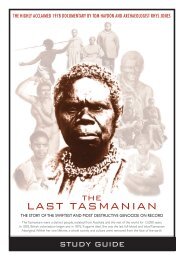

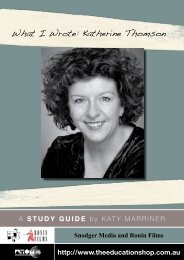
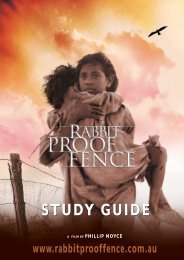

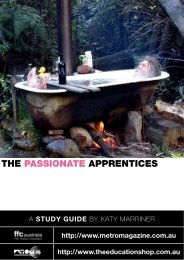
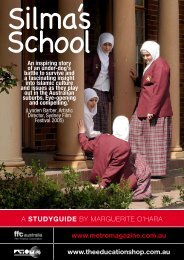
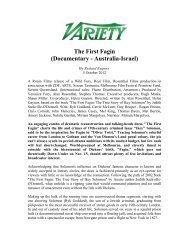

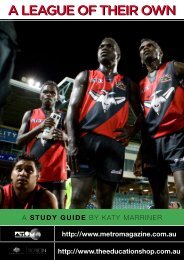
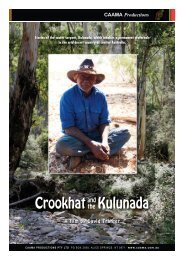
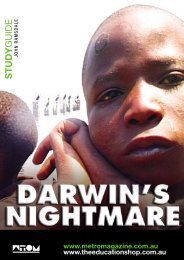
![to download FROHE OSTERN! [HAPPY EASTER!] - Ronin Films](https://img.yumpu.com/33740736/1/184x260/to-download-frohe-ostern-happy-easter-ronin-films.jpg?quality=85)
